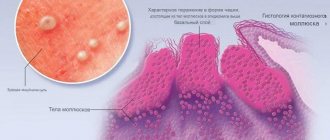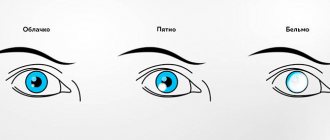What is xanthelasma of the eyelids?
Xanthelasmas are formations that belong to the subtype of xanthoma, but unlike them, they cannot degenerate into malignant tumors and do not pose a danger to the patient’s vision .
The danger of such skin plaques can only be present if they arose as an indirect symptom of more serious pathologies.
Translated from Greek, the word “xanthelasma” means “golden-yellow plate.”
Attention! This phenomenon occurs in the vast majority of older women, which is due to more frequent disorders of lipid metabolism in the female body compared to men.
Plaques can form mainly on the upper eyelids , spreading from the inner corners and rarely moving to the periocular space.
They are soft to the touch and resemble wen or blisters, and their presence for the patient himself can be either noticeable (if the xanthelasmas are large enough) or invisible.
Basically, such plaques cause more psychological discomfort than physical , but if such extraneous manifestations are detected, it is advisable to undergo an examination by an ophthalmologist to confirm that this is not a sign of hidden dangerous diseases.
Forms of plaque psoriasis
Based on the characteristics of the disease, plaque psoriasis can manifest itself in the following types of skin lesions:
- the plaques merge into a single spot of irregular shape, outwardly resembling the outlines of a geographical map;
- a pattern is formed on the inflamed area, similar in outline to a spiral;
- the pathological area in the center has a vacuum, so it looks like a ring;
- the lesion on the skin has a regular shape, similar to a saucer or cone;
- inflammation on the skin has a round shape with a concave center, which outwardly resembles the outline of a shell;
- Another type is when thickening of the skin is observed on the legs, because of this the pathology is often called “elephant psoriasis.”
The first signs of the disease may appear in children at an early age. But much more often, adolescents and adults suffer from this disease. The course of plaque psoriasis is chronic, for this reason the stages of exacerbation are replaced by periods when the main symptoms subside.
The disease can affect not only the skin, but also affect the functioning of other organs and systems. That is why you should not wait for the inflamed area to heal on its own. It is necessary to immediately consult a doctor to prescribe treatment to eliminate or reduce psoriasis plaques and not cause the condition to worsen.
Regardless of the course and stage of the disease, today effective methods of treating this disease have been developed, aimed at reducing symptoms and improving the quality of life of patients.
Symptoms of the disease
Xanthelasma of the eyelids are yellowish plaques , when palpated the patient does not feel pain .
In some cases, such formations are not
pointlike , but are combined into a continuous stripe .
Typically, plaques develop at about the same time on the eyelids of both eyes.
The appearance of plaques is not preceded by any serious visible changes in the skin.
The size of a xanthelasma can vary from a match head to a small pea, while a fully formed plaque will no longer undergo physical changes and transformations.
But over the years they will increase in size, and their number will also gradually increase.
Diagnostics
Keep in mind! To diagnose xanthelasma, there is no need for special diagnostic procedures, since these plaques are easily identified by most physicians.
But if this phenomenon is detected, the patient must undergo additional examination by an endocrinologist and dermatologist .
In each case of detection of xanthelasma, patients are instructed to undergo an examination designed to identify problems with lipid metabolism .
Why does psoriasis start on the hands?
Psoriasis on the hands in the form of single regular plaques is only a seemingly local pathological process. In fact, even 1-2 elements of the rash indicate the presence of a chronic inflammatory skin disease. Medicine has not yet been able to unravel all the mysteries of this disease. The exact causes of psoriasis have not been identified. It is only known that the pathological process is based on burdened heredity and immune disorders.
Currently, the genes responsible for the hereditary transmission of predisposition to psoriasis, including on the hands, are being identified and studied. Under the influence of genes, a change in metabolism occurs and a decrease in the content of enzymes that destroy substances involved in inflammatory reactions.
Immunity is also impaired, which leads to a multiple acceleration of cell division in the surface layers of the skin. The cells do not have time to mature when new underlying cells push them to the surface. This is another cause of psoriasis on the hands.
Psoriasis of any localization can spread throughout the body, so do not delay treatment.
See how easily the disease can be cured in 10-12 sessions.
Such changes lead to the appearance of characteristic symptoms of the disease. What does psoriasis look like on the hands? Initially, a scaly spot appears on the hands, sometimes on other parts of the body, which quickly turns into a papule with a raised inflammatory base. The papules grow and merge, forming huge plaques.
But not all genetically predisposed people develop the disease. The reason is the lack of exposure (or minor exposure) to provoking factors. If you avoid these factors, you may never get sick, even if both parents have psoriasis.
Treatment of xantilasma
Elimination of xanthelasma is only possible through surgery, which can be performed in different ways:
- Cryodestruction . Objects are burned with liquid nitrogen, causing them to die.
- Laser processing . Plaque tissues are evaporated sequentially and layer-by-layer using a directed medical laser.
- Chemical destruction . Treatment is carried out with trichloroacetic acid.
- Electrocoagulation. The formations are exposed to high-frequency current, resulting in local tissue destruction.
- Classic surgery using a scalpel . In this case, the formations are excised and separated from the eyelid.
You should know! Each method has its pros and cons in terms of aesthetic effect, and also depends on the size of the plaques.
Is treatment and removal possible at home?
Despite the popular folk methods of burning out xanthelasma at home, it is impossible to achieve complete, safe and painless removal at home.
In the best case, this approach will leave a person with scars on the eyelids; in the worst case, serious damage to the tissue of the eye and loss of vision are possible.
Treatment with folk remedies
Treatment with folk remedies is also unacceptable , but such recipes can be used after surgery to speed up the healing effect.
To do this, you can use rose hips, mint and immortelle leaves and mix them in the same ratio (one hundred grams of each ingredient).
The mixed components are crushed and three tablespoons of the product are poured into three glasses of water.
Next, the composition needs to be boiled for ten minutes and left to stand for four hours.
The cooled product, filtered through gauze, is taken orally, four times a day in equal portions strictly thirty minutes before meals.
Treatment of plaques in psoriasis
The treatment regimen for plaque psoriasis is selected in such a way as to influence the problem both from the outside and from the inside. An important role in planning therapy is played by the selection of drugs that help normalize immune functions, restore the entire chain of links in the immune reaction, so that the body responds correctly to external stimuli and does not attack its own cells.
When a doctor develops a treatment program for a particular patient, his task is to carefully analyze the characteristics of the course of the disease and the general health of the patient. Since in most cases we are talking about chronic plaque psoriasis, external treatment involves the use of relatively safe drugs that will not harm the body with long-term use.
In this regard, drugs from the Skin-cap line are the best fit. Many doctors choose them as primary and additional therapy in combination with other drugs in patients with plaque psoriasis.
Skin-cap preparations have both therapeutic and additional caring properties. The activated zinc pyrithione included in their composition provides a multidirectional effect:
- actively suppresses inflammation processes;
- controls the growth of bacterial and fungal flora;
- regulates the functioning of immune cells in the lesion;
- helps eliminate itching, flaking and a feeling of skin tightness.
Additionally, the formula of the Skin-cap line includes auxiliary components to moisturize the skin.
The use of Skin-cap products is justified both at the stage of exacerbation and during the period of subsidence of inflammation, when it is important to control the condition of the skin and control psoriasis.
Doctors prescribe not only self-therapy with Skin-cap if the disease manifests itself in a mild form, but also include them in a comprehensive treatment regimen for plaque psoriasis as an addition to corticosteroids and other drugs.
IMPORTANT! Long-term use of hormonal drugs (corticosteroids) can cause serious harm to the body. They should be used only as prescribed by a doctor, strictly observing the prescribed location and duration of use.
Average cost of xanthelasma removal in Russia
Depending on the type of surgical intervention, the cost of xanthelasma removal in Russian clinics will vary greatly.
The average cost of a classic type surgical operation will be 3,500 rubles for one plaque.
In other cases, the cost will range from 300 rubles and above, and the maximum price for removing formations will be as follows:
- electrocoagulation – 1,800 rubles;
- laser removal – 5,000 rubles;
- cryodestruction – 2,000 rubles.
The cost of other types of operations is discussed on a case-by-case basis with representatives of the selected clinic.
Prevention
There are no exact recommendations for prevention of xanthelasma.
Need to know! Experts can only give general recommendations that will help patients get out of the risk group and avoid the appearance of such formations with age:
- monitor your weight and introduce more healthy foods into your diet;
- add foods containing fiber , and also eat up to three hundred grams of vegetables and fruits daily;
- Replace animal fats with vegetable fats , but consume them in reasonable quantities;
- drink at least 1.5 liters of water per day ;
- exercise regularly ;
- try to give up smoking and alcohol ;
- control metabolism , if necessary, visit a nutritionist and endocrinologist.
New cholesterol controversy
When do you really need to lower cholesterol and who can live long with high levels? The material about this, prepared by KP, was among the top most read on the newspaper’s website.
Dossier "KP"
Philip Kopylov is a professor at the Department of Preventive and Emergency Cardiology, Director of the Institute of Personalized Medicine at Sechenov University, Doctor of Medical Sciences, researcher, cardiologist.
THE MAIN CHALLENGE FOR DOCTORS
Recently, an international group of cardiologists from Sweden, Italy, France, Japan and other countries made a revolutionary statement: there is no evidence to conclusively support the connection between high levels of “bad” cholesterol and cardiovascular disease. The researchers came to this conclusion after studying data from 1.3 million patients. Their health status was monitored for a total of about 50 years. Even more surprising, according to cardiologists, was that older people with high levels of low-density lipoproteins (the same “bad” cholesterol) live on average longer than others! How is this possible? Does this mean that scrambled eggs, butter and fatty meats have been finally rehabilitated, and doctors need to reconsider their approaches to treating heart patients with statin drugs?
“There may be two people standing in front of us, both of them have high cholesterol, only one needs to be treated, and the second can be left alone,” says Philip Kopylov. - Essentially, this is a solution-explanation of the results of a study on the role of cholesterol, which surprised many. The secret is that monitoring people from different risk groups gives different results. And medications act in different ways: if you give them to a sick person according to medical indications, his condition will improve. But if you feed someone who is healthy or who is not so sick that they really need serious medications, then there will be no improvement. The main task, I would even say a challenge, for modern doctors is to determine those who really need to lower cholesterol and when such patients really need statins. Because other people can live longer without treatment, including those with relatively high levels of “bad” cholesterol.
CHECK YOURSELF
What is your risk of cardiovascular disease?
A person is at low risk if they:
a) no high blood pressure. That is, the pressure is not higher than 130/80 mm Hg. Art. under the age of 65 and not higher than 140/80 after 65 years;
b) no excess weight. That is, the body mass index is not higher than 29 (we talked about how to calculate it in the first part of the publication);
c) no diabetes;
d) no atherosclerosis.
- Under such conditions, the patient usually does not need to be treated even if the level of “bad” cholesterol is elevated. That is, if the level of LDL (low-density lipoprotein) in the blood is up to 4.9 mmol/l, explains Philip Kopylov.
If a person is at high risk of cardiovascular disease, including a high risk of heart attack and stroke, then the cholesterol level should be no more than 2.6 mmol/l. And at a very high risk - a maximum of 1.8 mmol/l . If the indicators are higher, they need to be reduced, including with the help of medications.
into the high and very high risk group (depending on the number of risk factors and the degree of neglect) if:
1) is obese. The most dangerous thing is abdominal, that is, in the abdomen. Measure your waist width: for men the critical mark is 102 cm and more, for women – 88 cm and more;
2) high blood pressure (see point “a” above);
3) there is a diagnosis of diabetes mellitus (as a general rule, it is made when the blood sugar level is above 6.7 mmol/l on an empty stomach);
4) the patient abuses salt - exceeds the norm of 5 mg per day, including salt in all dishes and products;
5) overindulges in alcohol. Let us remind you that, according to the latest data, up to 14 servings of alcohol per week for men and up to 8 servings for women are considered relatively safe for health (how much this will be in different types of drinks - see the “Health” section on kp.ru);
6) male gender - the risk of cardiovascular diseases in men is a priori higher;
7) age - for women over 50 - 55 years old; for men - from 45 years old, and if the above factors are present - then starting from 35 years old.
CHOLESTEROL PLAQUE DIFFERENCES PLAQUE
- If I am not in a high or even medium risk group, does this mean that I can unlimitedly eat foods with animal fats - butter, fatty meat, etc.?
— The question is not easy. When we begin to lean on foods rich in animal fats, with a modern sedentary lifestyle, this often results in obesity. You receive at least one risk factor and move from a more “favorable” group to a less favorable one, with a higher risk. And in general, we must admit: the regulation of the system of production and metabolism of cholesterol in the body still partially remains a mystery to scientists. We don't know everything about her.
— Is it undeniable that cholesterol plaques in blood vessels are harmful and dangerous? Or do you also have doubts?
— In humans, already from adolescence, damage to the internal lining of blood vessels begins. And atherosclerotic plaques develop with age in the vast majority of people (essentially, such plaques are accumulations of cholesterol deposits in places of vascular damage. - Author) . However, the problem is that plaques are not all the same. They can be of two types: stable and unstable. And the most serious challenge in cardiology now is to learn to identify and calculate unstable plaques.
- What is their danger?
- At least half of myocardial infarctions occur due to plaques that do not narrow the lumen in the blood vessels or narrow it less than 50%. Such plaques have a thin covering film and a liquid core, where inflammation constantly occurs. Eventually the tire simply breaks. A blood clot forms at this site and blocks the lumen of the vessel. And everything downstream of the blood begins to die.
TO EXERCISE OR NOT TO EXERCISE?
- It is often said that aerobic exercise - brisk walking, running, swimming, ice skating - is useful for increasing blood circulation. And if the plaques are unstable, then it turns out that increased blood flow can worsen the situation?
— Purely theoretically, yes. However, if these loads are regular and reasonable (see below for the “golden” formula for calculating heart rate. - Author) , then they will have a positive effect. Weight and blood pressure will decrease. Also, as a rule, there is a decrease in cholesterol. That is, risk factors are eliminated, and due to this, competent physical exercise brings undeniable benefits. And if you exercise from time to time, and even try to set an Olympic record in the rare moments of your appearance at the gym, then the threat of rupture of plaques and a heart attack really increases significantly.
ON A NOTE
How to determine safe exercise intensity
Use the “golden formula” for calculating your optimal heart rate: 220 minus your age. the resulting figure by 65% - this is the pulse at a moderate load; multiply by 80% - heart rate during intense physical activity. If it is higher, there is already an excessive load, unfavorable for the blood vessels and heart.
QUESTION: WHO NEEDS STATINS?
— Philip Yuryevich, what about statins? Recently, there has been heated debate; the authors of an international study claim that the benefits of such drugs are very doubtful. To whom and why should they be prescribed from your point of view - as a researcher and cardiologist?
- Let's remember: cholesterol enters our body not only with food, 60 - 70% of it is produced in the liver, even if you are on a lean diet. The effect of statins is, on the one hand, to inhibit the production of cholesterol in the liver. At the same time, a mechanism is launched that turns existing unstable plaques into stable ones. And this actually cuts the risk of heart attacks in half.
— It turns out that if a person’s plaques are stable and do not block the lumen of blood vessels, then there are no indications for taking statins? After all, these drugs have serious side effects - from muscle and joint pain to increased blood sugar. When the task is to protect against a real threat, a fatal heart attack, then such “costs” are the lesser of the evils. Are there any current developments to determine the type of plaque in a particular patient?
— There is an intravascular method, when we insert a special sensor into the vessel and use ultrasound or optical coherence tomography to determine the structure of the plaque.
- Do you need to check every plaque?
- Yes. And the sensor, unfortunately, is expensive. Another approach is computed tomography. We put the patient in a computer scanner and do an X-ray examination with contrast of the heart vessels. The resolution of computed tomographs today makes it possible to determine what kind of plaque it is - stable or unstable.
The third approach is a blood test. Now it is actively developing. Very interesting research work is being carried out on microRNAs, that is, small molecules that are responsible for inflammation and the development of atherosclerosis. Based on their presence, concentration and combination, they are trying to build diagnostic systems to identify unstable plaques.
— Are any of these methods used in Russia?
- So far - on a minimal scale, only in large cardio centers, and then as research work for the most part. In general, the problem of determining the type of plaques is solved in different ways throughout the world. The latest international recommendations propose the introduction of computed tomography with contrast as a method of primary diagnosis.
CONGRATULATIONS!
“Sechenovka” has an anniversary!
In 2022, Sechenov University, First Honey, the legendary “Sechenovka”, as it is often called among the people, turns 260 years old. Over these centuries, they worked, taught, treated, created breakthrough methods for saving people here, and most Russian medical luminaries continue to do so. Among the stars of the university is the founder of the school of military field medicine, Nikolai Pirogov ; famous surgeon, professor Nikolai Sklifosofsky ; the founder of Russian forensic psychiatry Vladimir Serbsky ; founder of the medical examination system Nikolai Semashko ; founder of neurosurgery Nikolai Burdenko; founder of the school of cardiovascular surgery Alexander Bakulev . Now among the professors at Sechenovka are academician Leo Bockeria , the chief transplantologist of the Russian Ministry of Health, academician Sergei Gauthier , one of the leading Russian oncological surgeons, an expert on head and neck tumors, academician Igor Reshetov , and many others.
«
Komsomolskaya Pravda" congratulates Sechenov University and wishes new scientific and medical breakthroughs!
Link to publication:










